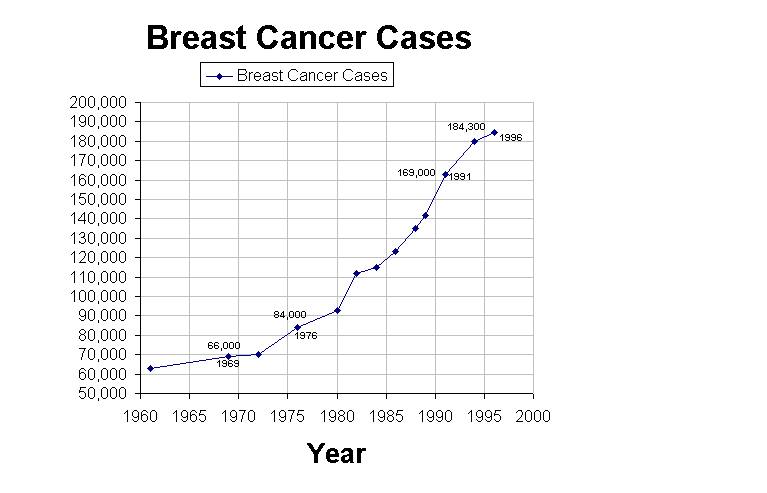
ASPARTAME &
CANCERS
Return to Subject Index - Main Index
Date: Thu, 25 Mar 1999 22:20:40 EST
George R. Schwartz, M.D.
www.healthpress.com/cancer.htm
Summary
There is a startling epidemiologic connection between NutraSweet (aspartame) and breast cancer. The biochemical mechanism which can explain the correlation offers additional weight to the epidemiologic research finding. This extraordinary correlation points to millions of breast cancer cases possibly induced by NutraSweet (aspartame). This alarming association mandates an emergency need for close scientific scrutiny.
Mechanism of Action
NutraSweet (aspartame) is composed of linkages of aspartic acid, phenylalanine and methanol. The aspartic acid acts as a neuroexcitatory agent. (1) When NutraSweet is digested, it yields 10% methanol (wood alcohol).(2) The wood alcohol (methanol) is widely distributed throughout the body including brain, muscle, fat and nervous tissue. (3) It is then metabolized to formaldehyde which enters the cells and binds to the proteins and DNA (the genetic material). (4) Cytogenetic effects (changes in DNA) have been shown to result from formaldehyde exposure (5) and DNA damage occurs from formaldehyde.(6) The nature of the injury generally involves breaking and then creation of cross linking within the genetic material which alters the cells.
This finding has been confirmed numerous times and the DNA-protein-cross-links are believed to cause cancers in experimental animals.(7) Changes in the genetic material is associated with cancer production in humans.(8) The ability of Aspartame to cause cellular mutations has been shown through studies by Shephard, et al.(9) There are increases in malignant brain tumors suggested to be associated with aspartame use.(10) Formaldehyde is a known stimulant for cancer and genetic damage in the cell . .(11, 12)
Epidemiology Research
Our epidemiologic research demonstrates the following:
**Rising incidence of breast cancer in the United States (more than 180,000 new cases yearly and now the single leading cause of death in woman age 35-54) (13) over 25 years tracking increased aspartame use. (In 1974 NutraSweet was approved for limited use, in 1983 it was approved for use in diet sodas.) Note chart.
**We are now studying the rising incidence of prostate cancer, with more than 132,000 new cases yearly and the second most common cancer in men.(14) This cancer also appears to epidemiologically be associated with a rise in aspartame use.
**Rising incidence of brain cancers.(15)
Cancer statistics also note that rates of breast and prostate cancer are 5 to 6 times higher in North American and Europe than in Asia and Africa, places where NutraSweet market penetration has so far been less.(16, 17)
Chart of Pivotal Dates

The chart of breast cancer increases demonstrates these pivotal times. Testing involving NutraSweet occurred in the l972-l973 period. Limited approval as a sweetener was granted (in the USA) in l974 and full unlimited approval was granted in l983. Arrows on the chart demonstrate the extraordinary concordance with increasing breast cancer rates. The likelihood of this being a rare coincidence is offset by the biochemical evidence supporting a likely mechanism for cancer induction. Early animal experiments involving mice did demonstrate mammary tumors and urogenital changes in males which were found in initial testing prior to NutraSweet approval.
Hypothesis
The epidemiologic correlation's are striking and raise the hypothesis of cancer induction. While there are many potential pathways, we are postulating the most direct. NutraSweet converts to methanol, which goes to intracellular formaldehyde. The latter affects DNA causing cell toxicity and chromosome abnormalities which precipitate cancers in susceptible people. NutraSweet has already been shown to induce mammary tumors and testicular changes in experimental animals.(18) Based on the epidemiologic associations, and biochemical effects at the cellular-DNA level, NutraSweet and aspartame should be carefully studied as a potential environmental cause of well over one million cases of cancer.
Endnotes
1. Blaylock, Russell L.: Excitotoxins: The Taste that Kills, 1997, Health Press.
2. Team
NutraSweet, Monsanto Response, 1999.
3. Osborn H. Alcohol Substitutes. Treatment of Poisonings
by Methanol, Ethlyene Glycol and Isopropyl Alcohol p. 741-5 in Schwartz GR, et
al. Eds, Principles and Practice of Emergency Medicine, Lippincott/Williams
& Wilkins, 1999.
4.
Trocho, et al. Formaldehyde Derived From Dietary "Aspartame Binds to Tissue
Components In Vivo. Life Sciences 63(5):337-349, 1998.
5. Shaham D, et al. DNA-Protein Crosslinks:
A Biomarker of Exposure to Formaldehyde. Carcinogenesis, Jan.
1996.
6. Ross WE, McMillan DR,
Ross CF: Comparison of DNA Damage by Methylmelamines and Formaldehyde, Journal
National Cancer Institute 67:217-21, 1981.
7. Cassanova, et al.: DNA-Protein Cross-links and Cell
Replication at Specific Sites in the Nose of F344 Rats Exposed Subchronically
to Formaldehyde, Fundamental and Applied Toxicology 223, 535-536,
1994.
8. Olopade OI, Rowley
JD: Recurring Chromosome Re-arrangements in Human Cancer. P. 99-120, in
Holland JF et al Eds., Cancer Medicine. 3rd edition, Lea & Febiger,
1993.
9. Shephard, et al.,
Mutagenics Activity of Peptides and the Artificial Sweetener Aspartame after
Nitrosation. Fd Chem Toxic 1993:31:323-29.
10. Olney JW, et al.: Increasing brain tumor rates: is
there a link to aspartame?. J Neuropath Exp Neurol 1996 Nov, 55:11,
1115-23.
11. Cassanova, et
al.
12. Crosby RM, et al:
Molecular analysis of formaldehyde-induced mutations in human lymphoblasts and
E.Coli. Environ Mol Mutagen. 12, 155-166, 1988.
13. Fisher B, et al.: Neoplasms of the Breast. P.
1706-1774, Cancer Medicine, 3rd Ed. Lea & Febiger, 1993.
14. Trump DL, Neoplasms of the Prostate. p.
1562-1580, Cancer Medicine, 3rd Ed. Lea & Febiger, 1993.
15. Olney, see 10.
16. Fisher, see 13.
17. Trump, see 14.
18. GP Searle research reported to FDA
1971-74, released under Freedom of Information Act.
For more information:
Dr. George R. Schwartz, M.D.
(505) 982-9373
Distributed by Mission Possible
Canada - 308-40 Bay Mills Blvd - Toronto - ON - Canada -MIT3P5
Tel: 416-754-2004
- E-mail: aspartame@aspartame.ca - Web site:
www.aspartame.ca
DISABILITY AND DEATH ARE NOT ACCEPTABLE COSTS OF BUSINESS
Return to - Homepage - Hoofd Index